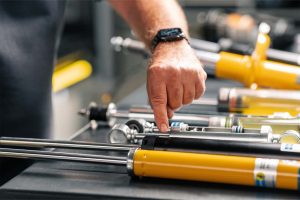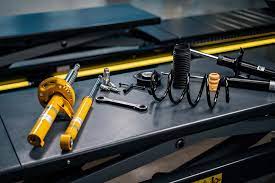Shock absorbers are among the most vital components in your vehicle’s suspension system. They ensure that your tyres remain in contact with the road, improving handling, braking, and overall comfort. However, even brand-new, high-quality shock absorbers can fail prematurely — not because of manufacturing defects, but due to installation mistakes. Incorrect fitting or oversight during installation can compromise performance, safety, and longevity, turning your investment into an unnecessary expense.
In this article, we’ll explore the most common installation errors, their effects, and how to avoid them.
Understanding the Role of Shock Absorbers

Before discussing installation issues, it’s important to remember what shock absorbers do:
-
Control spring oscillations after road impacts
-
Maintain tyre contact with the ground
-
Prevent body roll and excessive bouncing
-
Enhance steering stability and braking efficiency
Even a small mistake during installation can disrupt these critical functions.
The Most Frequent Installation Mistakes
1. Reusing Old Mounting Hardware
One of the most overlooked errors is reusing old bolts, bushings, and mounts. These parts are often worn, corroded, or weakened after years of use. Installing new shocks on old mounts introduces instability and noise, while increasing stress on the damper rod.
Recommendation:
-
Always replace mounting hardware, especially rubber bushings and washers.
-
Use torque specifications recommended by the manufacturer.
2. Incorrect Torque Application
Tightening bolts “by feel” instead of using a torque wrench is another major mistake. Over-torquing can strip threads or compress bushings too tightly, while under-torquing can lead to movement and premature wear.
| Component | Effect of Under-Torquing | Effect of Over-Torquing |
|---|---|---|
| Upper mount bolts | Noise, loosening | Bushing damage, thread stripping |
| Lower eye bolt | Misalignment | Bolt or sleeve deformation |
| Top nut on piston rod | Knocking sound | Internal valve damage |
Tip: Always tighten with the vehicle’s weight on its wheels, not while the suspension is hanging freely.
3. Failing to Prime Hydraulic Shock Absorbers
Hydraulic and twin-tube shocks must be primed before installation to remove trapped air from the internal chambers. Skipping this step can cause air bubbles to interfere with damping, leading to poor performance and noise.
How to prime a shock absorber:
-
Hold it upright and compress fully.
-
Slowly extend to full length.
-
Repeat 3–5 times until motion becomes smooth and consistent.
4. Installing Shocks Upside Down
Many shock absorbers look symmetrical, but they are direction-sensitive. Installing them upside down can block oil flow or damage internal seals. Gas-charged shocks, in particular, require the correct orientation for proper gas pressure balance.
Check:
-
Follow the manufacturer’s “TOP” or “UP” markings.
-
Refer to the fitting diagram in the product manual.
5. Ignoring Suspension Geometry and Alignment
After replacing shocks, the suspension geometry often changes slightly. If wheel alignment isn’t checked afterward, it can cause:
-
Uneven tyre wear
-
Poor handling and pulling to one side
-
Reduced fuel efficiency
Solution:
Always perform a four-wheel alignment after installation. This ensures that camber, caster, and toe angles are within specification.
6. Mixing Shock Types or Brands
Some mechanics install different types (e.g., gas on one axle, hydraulic on another) or brands to save costs. However, this creates an imbalance in damping characteristics, leading to instability and premature wear.
| Combination Type | Resulting Issue |
|---|---|
| Gas + hydraulic | Uneven response on bumpy roads |
| New + old shocks | Excessive roll and nose-dive |
| Different brands | Damping imbalance, unpredictable handling |
Rule of thumb: Replace shocks in pairs (front or rear) and use the same type and brand on both sides.
7. Forgetting to Tighten Bushings at Ride Height
Rubber bushings must be tightened with the car on the ground. If you tighten them while the suspension is hanging, the bushings twist under load when lowered, causing early failure and squeaking.
Correct procedure:
-
Install shocks loosely with the vehicle lifted.
-
Lower the car so that the suspension carries full weight.
-
Tighten all bushing bolts to the specified torque.
8. Neglecting to Check for Leaks or Contamination
Sometimes new shocks are installed in dirty conditions or near leaking components (like oil seals or brake fluid lines). Contaminants degrade the rubber components and cause corrosion.
Preventive steps:
-
Clean all mounting points thoroughly.
-
Replace any leaking seals near the suspension.
-
Inspect boots and dust covers to prevent grit ingress.
How These Mistakes Impact Performance and Longevity
| Mistake | Consequence | Potential Cost |
|---|---|---|
| Wrong torque | Bushing/rod damage | €50–€150 repair |
| Skipped priming | Poor damping, early failure | €100–€200 replacement |
| No alignment | Tyre wear, poor handling | €200+ for tyres |
| Mixed brands | Instability, vibration | Reduced ride comfort |
| Tightened off-load | Torn bushings | Rework required |
Small errors at installation can quickly multiply into hundreds of euros in unnecessary costs.
Professional Tips for Correct Shock Installation
To ensure the best performance from your new shock absorbers:
-
Use OEM-equivalent or premium brands designed for your car.
-
Inspect springs, mounts, and control arms before fitting.
-
Tighten all bolts with calibrated torque tools.
-
Replace dust boots and bump stops during installation.
-
Perform a road test after installation to verify damping and noise.
-
Recheck fasteners after 100–200 km of driving.
Long-Term Maintenance for Shock Absorbers

Once properly installed, shocks can last between 70,000 and 100,000 km, depending on driving style and road conditions. To extend their lifespan:
-
Avoid overloading the vehicle.
-
Wash undercarriage regularly to remove salt and dirt.
-
Inspect for leaks or corrosion twice a year.
-
Replace shocks in pairs and on schedule.
Proper care not only keeps your vehicle safe but also preserves tyre life, suspension joints, and ride comfort.
Conclusion
Even the best shock absorbers can fail prematurely if installed incorrectly. From improper torque to neglecting priming, every small detail matters. Ensuring correct procedures during installation guarantees that your suspension system performs as designed — offering smooth rides, predictable handling, and long-term savings.
If you’re replacing your shocks, make sure you choose high-quality components and install them correctly. For a wide range of reliable and affordable options, visit:
Buy Shock Absorbers online
Your vehicle’s performance, safety, and comfort depend on how well those shocks are installed — don’t let simple mistakes ruin a new set.